The Sustainability of Regional Innovation in China: Insights from Regional Innovation Values and Their Spatial Distribution
Abstract
1. Introduction
2. Literature Review and Research Hypotheses
2.1. The Value of Innovation
2.2. The Spatial Distribution of Regional Innovation
3. Methods and Data
3.1. Methodology
Original Model: Patent Renewal Model
3.2. Extended Model: Regional Innovation Value Model
3.3. Data Description
3.3.1. Patent Data
3.3.2. Data for Regional Innovation Indicators
4. Results and Discussion
4.1. Estimation of Regional Innovation Value Model
4.1.1. Correlation between Regional Innovation Indicators and Sample Renewal Proportion
4.1.2. Regression Results for the Regional Innovation Value Model
4.1.3. Robustness Test
4.2. Regional Innovation Values in China
4.2.1. Calculation of Regional Innovation Value
4.2.2. Nationwide Innovation Value
4.2.3. City-Level Innovation Value
4.2.4. Area-Level Innovation Value
4.3. Spatial Distribution of Regional Innovation Values in China
4.3.1. Overall View of the Spatial Distribution of Regional Innovation Values
4.3.2. Spatial Correlation of Regional Innovation Values
5. Conclusions and Policy Recommendations
6. Limitations and Future Researches
Funding
Institutional Review Board Statement
Informed Consent Statement
Data Availability Statement
Conflicts of Interest
References
- Boeing, P.; Mueller, E.; Sandner, P. China’s R&D Explosion—Analyzing Productivity Effects across Ownership Types and Over Time. Res. Policy 2016, 45, 159–176. [Google Scholar]
- Feng, W.; Li, J. International Technology Spillovers and Innovation Quality: Evidence from China. Econ. Anal. Policy 2021, 72, 289–308. [Google Scholar] [CrossRef]
- Hu, A.; Jefferson, G. A great wall of patents: What is behind China’s recent patent explosion? J. Dev. Econ. 2009, 90, 57–68. [Google Scholar] [CrossRef]
- Gao, K.; Yuan, Y. Government intervention, spillover effect and urban innovation performance: Empirical evidence from national innovative city pilot policy in China. Technol. Soc. 2022, 70, 102035. [Google Scholar] [CrossRef]
- Wang, J.; Ma, X.; Zhao, Y.; Zhao, J.; Heydari, M. Impact of scientific and technological innovation policies on innovation efficiency of high-technology industrial parks—A dual analysis with linear regression and QCA. Int. J. Innov. Stud. 2022, 6, 169–182. [Google Scholar] [CrossRef]
- Zeng, J.; Ning, Z.; Lassala, C.; Ribeiro-Navarrete, S. Effect of innovative-city pilot policy on industry-university-research collaborative innovation. J. Bus. Res. 2023, 162, 113867. [Google Scholar] [CrossRef]
- Xu, A.; Qiu, K.; Jin, C.; Cheng, C.; Zhu, Y. Regional innovation ability and its inequality: Measurements and dynamic decomposition. Technol. Forecast. Soc. Change 2022, 180, 121713. [Google Scholar] [CrossRef]
- Tu, W.; Zhang, L.; Sun, D.; Mao, W. Evaluating high-tech industries’ technological innovation capability and spatial pattern evolution characteristics: Evidence from China. J. Innov. Knowl. 2023, 8, 100287. [Google Scholar] [CrossRef]
- Schankerman, M.; Pakes, A. 1986. Estimates of the Value of Patent Rights in European Countries during the Post-1950 Period. Econ. J. 1986, 96, 1052–1076. [Google Scholar] [CrossRef]
- Bresnahan, T.; Trajtenberg, M. General Purpose Technologies ‘Engines of Growth’? J. Econom. 1995, 65, 83–108. [Google Scholar] [CrossRef]
- Bessen, J. The Value of US Patents by Owner and Patent Characteristics. Res. Policy 2008, 37, 932–945. [Google Scholar] [CrossRef]
- Zhang, G.; Duan, H.; Wang, S.; Zhang, Q. Comparative technological advantages between China and developed areas in respect of energy production: Quantitative and qualitative measurements based on patents. Energy 2018, 162, 1223–1233. [Google Scholar] [CrossRef]
- Li, X. China’s regional innovation capacity in transition: An empirical approach. Res. Policy 2009, 38, 338–357. [Google Scholar] [CrossRef]
- Wei, Y.; Zhang, H.; Wei, J. Patent elasticity, R&D intensity and regional innovation capacity in China. World Pat. Inf. 2015, 43, 50–59. [Google Scholar]
- Xu, A.; Qiu, K.; Zhu, Y. The measurements and decomposition of innovation inequality: Based on Industry-University-Research perspective. J. Bus. Res. 2023, 157, 113556. [Google Scholar] [CrossRef]
- Zhou, J.; Wang, G.; Lan, S.; Yang, C. Study on the Innovation Incubation Ability Evaluation of High Technology Industry in China from the Perspective of Value-Chain An Empirical Analysis Based on 31 Provinces. Procedia Manuf. 2017, 10, 1066–1076. [Google Scholar] [CrossRef]
- Chen, H.; Lin, H.; Zou, W. Research on the Regional Differences and Influencing Factors of the Innovation Efficiency of China’s High-Tech Industries: Based on a Shared Inputs Two-Stage Network DEA. Sustainability 2020, 12, 3284. [Google Scholar] [CrossRef]
- Chen, Y.; Shi, H.; Ma, J.; Shi, V. The Spatial Spillover Effect in Hi-Tech Industries: Empirical Evidence from China. Sustainability 2020, 12, 1551. [Google Scholar] [CrossRef]
- Nagaoka, S.; Motohashi, K.; Goto, A. Patent statistics as an innovation indicator. In Handbook of the Economics of Innovation, 1st ed.; Hall, B., Rosenberg, N., Eds.; North-Holland: Oxford, UK, 2010; Volume 2, pp. 1083–1127. [Google Scholar]
- Lee, K. The value and direction of innovation. J. Econ. 2020, 130, 133–156. [Google Scholar] [CrossRef]
- Bound, J.; Cummins, C.; Griliches, Z.; Hall, B.H.; Jaffe, A. Who does R&D and who patents? In R&D, Patents, and Productivity, 1st ed.; Griliches, Z., Ed.; University of Chicago Press: Chicago, IL, USA, 1984; pp. 21–54. [Google Scholar]
- Griliches, Z. 1990. Patent Statistics as Economic Indicators: A Survey. J. Econ. Lit. 1990, 28, 1667–1707. [Google Scholar]
- Zhang, G.; Lv, X.; Zhou, J. Private value of patent right and patent infringement: An empirical study based on patent renewal data of China. China Econ. Rev. 2014, 28, 37–54. [Google Scholar] [CrossRef]
- Gambardella, A. The Economic Value of Patented Inventions: Thoughts and Some Open Questions. Int. J. Ind. Organ. 2013, 31, 626–633. [Google Scholar] [CrossRef]
- Chen, J.; Cheng, J.; Dai, S. Regional eco-innovation in China: An analysis of eco-innovation levels and influencing factors. J. Clean. Prod. 2017, 153, 1–14. [Google Scholar] [CrossRef]
- Miremadi, I.; Saboohi, Y.; Jacobsson, S. Assessing the performance of energy innovation systems: Towards an established set of indicators. Energy Res. Social Sci. 2018, 40, 159–176. [Google Scholar] [CrossRef]
- Tan, F.; Gong, C.; Niu, Z. How does regional integration development affect green innovation? Evidence from China’s major urban agglomerations. J. Clean. Prod. 2022, 379, 134613. [Google Scholar] [CrossRef]
- Freeman, C. Technology Policy and Economic Performance: Lessons from Japan, 1st ed.; Pinter: London, UK, 1987. [Google Scholar]
- Lundvall, B. National Systems of Innovation: Towards A Theory of Innovation and Interactive Learning, 1st ed.; Pinter: London, UK, 1992. [Google Scholar]
- Nelson, R. Nation Innovation Systems: A Comparative Analysis, 1st ed.; Pinter: London, UK, 1992. [Google Scholar]
- Cooke, P. Regional Innovation Systems: Competitive Regulation in the New Europe. Geoforum 1992, 23, 365–382. [Google Scholar] [CrossRef]
- Cooke, P.; Uranga, M.; Etxebarria, G. Regiona innovation systems: Institutional and organizational dimensions. Res. Policy 1997, 26, 475–491. [Google Scholar] [CrossRef]
- Zhang, G.; Chen, X. The value of invention patents in China: Country origin and technology field differences. China Econ. Rev. 2012, 23, 357–370. [Google Scholar]
- Huang, C. Estimates of the value of patent rights in China. In Innovation and IPRs in China and India; United Nations University Working Paper Series; Springer: Singapore, 2012. [Google Scholar] [CrossRef]
- Liu, L.; Cao, C.; Song, M. China’s agricultural patents: How has their value changed amid recent patent boom? Technol. Forecast. Soc. Change 2014, 88, 106–121. [Google Scholar] [CrossRef]
- Lanjouw, J. Patent Protection in the Shadow of Infringement: Simulation Estimations of Patent Value. Rev. Econ. Stud. 1998, 65, 671–710. [Google Scholar] [CrossRef]
- Harhoff, D.; Scherer, F.; Vopel, K. Citations, Family Size, Opposition and the Value of Patent Rights. Res. Policy 2003, 32, 1343–1363. [Google Scholar] [CrossRef]
- Goto, A.; Motohashi, K. Construction of a Japanese Patent Database and a First Look at Japanese Patenting Activities. Res. Policy 2007, 36, 1431–1442. [Google Scholar] [CrossRef]
- Pakes, A.; Schankerman, M. The Rate of Obsolescence of Knowledge, Research Gestation Lags, and the Private Rate of Return to Research Resources. In R&D, Patents, and Productivity, 1st ed.; Griliches, Z., Ed.; University of Chicago Press: Chicago, IL, USA, 1984; pp. 73–88. [Google Scholar]
- Pakes, A. Patents as Options: Some Estimates of the Value of Holding European Patent Stocks. Econometrica 1986, 54, 755–784. [Google Scholar] [CrossRef]
- Deng, Y. A Dynamic Stochastic Analysis of International Patent Application and Renewal Process. Int. J. Ind. Organ. 2011, 29, 766–777. [Google Scholar] [CrossRef]
- Lanjouw, J.; Schankerman, M. Patent Quality and Research Productivity: Measuring Innovation with Multiple Indicators. Econ. J. 2004, 114, 441–465. [Google Scholar] [CrossRef]
- Hall, B.; Jaffe, A.; Trajtenberg, M. Market Value and Patent Citation. Rand J. Econ. 2005, 36, 16–38. [Google Scholar]
- Lanjouw, J.; Pakes, A.; Putnam, J. How to Count Patents and Value Intellectual Property: The Uses of Patent Renewal and Application Data. J. Ind. Econ. 1998, 46, 405–432. [Google Scholar] [CrossRef]
- Og, J.; Pawelec, K.; Kim, B.; Paprocki, R.; Jeong, E. Measuring Patent Value Indicators with Patent Renewal Information. J. Open Innov. Technol. Mark. Complex. 2020, 6, 16. [Google Scholar] [CrossRef]
- Tödtling, F.; Kaufmann, A. Innovation Systems in Regions of Europe—A Comparative Perspective. Eur. Plan. Stud. 1999, 7, 699–717. [Google Scholar] [CrossRef]
- Furman, J.L.; Porter, M.E.; Stern, S. The Determinants of National Innovative Capacity. Res. Policy 2002, 31, 899–933. [Google Scholar] [CrossRef]
- Furman, J.; Hayes, R. Catching Up or Standing Still? National Innovative Productivity Among ‘Follower’ Countries, 1978–1999. Res. Policy 2004, 33, 1329–1354. [Google Scholar] [CrossRef]
- Hu, M.; Mathews, J. National Innovative Capacity in East Asia. Res. Policy 2005, 34, 1322–1349. [Google Scholar] [CrossRef]
- Deng, Y. Private value of European patents. Eur. Econ. Rev. 2007, 51, 1785–1812. [Google Scholar] [CrossRef]
- Jaffe, A. Technological Opportunity and Spillovers of R&D: Evidence from Firms’ Patents, Profits, and Market Value. Am. Econ. Rev. 1986, 76, 984–1011. [Google Scholar]
- Jaffe, A. Real Effects of Academic Research. Am. Econ. Rev. 1989, 79, 957–970. [Google Scholar]
- Wang, N.; Hagedoorn, J. The lag structure of the relationship between patenting and internal R&D revisited. Res. Policy 2014, 43, 1275–1285. [Google Scholar]
- Wang, D.; Zhang, X.; Zhang, Z. The Time Lags Effects of Innovation Input on Output in National Innovation Systems: The Case of China. Discrete Dyn. Nat. Soc. 2016, 8, 1–12. [Google Scholar] [CrossRef]
- Hu, M.; Lu, Y.; Lai, C. Patent term extensions and commercialization lags in the pharmaceutical industry: A growth-theoretic analysis. J. Macroecon. 2023, 76, 103519. [Google Scholar] [CrossRef]
- Hall, B.; Mairesse, J.; Branstetter, L.; Mulkay, B. Does Cash Flow Cause Investment and R&D: An Exploration Using Panel Data for French, Japanese, and United States Scientific Firms. IFS Working Paper 1998, W98/11. Available online: https://ifs.org.uk/publications/does-cash-flow-cause-investment-and-rd-exploration-using-panel-data-french-japanes-and (accessed on 31 May 2022).
- Huang, C.; Hou, T. Innovation, research and development, and firm profitability in Taiwan: Causality and determinants. Int. Rev. Econ. Financ. 2019, 59, 385–394. [Google Scholar] [CrossRef]
- Chen, S.; Huang, W. Innovation input-output and output-lagged input relationships of the next-generation information industry in China. Inf. Process Manag. 2022, 59, 103066. [Google Scholar] [CrossRef]
- Taques, F.; Lopez, M.; Basso, L.; Areal, N. Indicators used to measure service innovation and manufacturing innovation. J. Innov. Knowl. 2021, 6, 11–26. [Google Scholar] [CrossRef]
- Pan, X.; Li, J.; Shen, Z.; Song, M. Life cycle identification of China’s regional innovation systems based on entropy weight disturbing attribute model. Habitat Int. 2023, 131, 102725. [Google Scholar] [CrossRef]
- Institute of Scientific and Technical Information of China (ISTIC). Evaluation Report on the Innovation Capacity of National Innovative Cities 2021, 1st ed.; Scientific and Technical Documentation Press: Beijing, China, 2022. (In Chinese) [Google Scholar]
- Chinese Academy of Science and Technology for Development.; Institute of Innovation and Entrepreneurship Management of University if Chinese Academy of Sciences. Evaluation Report on China’s Regional Innovation Capacity 2021, 1st ed.; Scientific and Technical Documentation Press: Beijing, China, 2022. (In Chinese) [Google Scholar]
- Rouvinen, P. R&D—Productivity Dynamics: Causality, Lags, and “Dry Holes”. J. Appl. Econ. 2002, 5, 123–156. [Google Scholar]
- Zhang, Y.; Cui, M. Determining the innovation efficiency of resource-based cities using a relational network dea model: Evidence from China. Extr. Ind. Soc. 2020, 7, 1557–1566. [Google Scholar] [CrossRef]
- Martinidis, G.; Komninos, N.; Carayannis, E. Taking into Account the Human Factor in Regional Innovation Systems and Policies. J. Knowl. Econ. 2022, 13, 849–879. [Google Scholar] [CrossRef]
- Xie, X.; Liu, X.; Blanco, C. Evaluating and forecasting the niche fitness of regional innovation ecosystems: A comparative evaluation of different optimized grey models. Technol. Forecast. Soc. Change 2023, 191, 122473. [Google Scholar] [CrossRef]
- Zhang, D.; Xu, J.; Zhang, Y.; Wang, J.; He, S.; Zhou, X. Study on sustainable urbanization literature based on Web of Science, scopus, and China national knowledge infrastructure: A scientometric analysis in CiteSpace. J. Clean. Prod. 2020, 264, 121537. [Google Scholar] [CrossRef]
- Hsu, D.; Hsu, P.; Zhao, Q. Rich on paper? Chinese firms’ academic publications, patents, and market value. Res. Policy 2021, 50, 104319. [Google Scholar] [CrossRef]
- Shan, D. Research of the Construction of Regional Innovation Capability Evaluation System: Based on Indicator Analysis of Hangzhou and Ningbo. Procedia Eng. 2017, 174, 1244–1251. [Google Scholar] [CrossRef]
- Cao, L.; Wu, Y.; Li, L. The driving effect of energy efficiency change: From the perspective of collaborative innovation development pattern. Environ. Impact Assess. Rev. 2023, 99, 107011. [Google Scholar] [CrossRef]
- Liang, L.; Li, Y. How does government support promote digital economy development in China? The mediating role of regional innovation ecosystem resilience. Technol. Forecast. Soc. Change 2023, 188, 122328. [Google Scholar] [CrossRef]
- Wang, Z.; He, Q.; Xia, S.; Sarpong, D.; Xiong, A.; Maas, G. Capacities of business incubator and regional innovation performance. Technol. Forecast. Soc. Change 2020, 158, 120125. [Google Scholar] [CrossRef]
- Hu, Y.; Ahmad, A.; Lu, D. Performance management challenges at Chinese business incubators: A systematic literature review. Technol. Forecast. Soc. Change 2023, 190, 122414. [Google Scholar] [CrossRef]
- Wang, C.; Wu, A. Geographical FDI knowledge spillover and innovation of indigenous firms in China. Int. Bus. Rev. 2016, 25, 895–906. [Google Scholar] [CrossRef]
- Feng, Y.; Wang, X.; Du, W.; Wu, H.; Wang, J. Effects of environmental regulation and FDI on urban innovation in China: A spatial Durbin econometric analysis. J. Clean. Prod. 2019, 235, 210–224. [Google Scholar] [CrossRef]
- Amabile, T. The social psychology of creativity: A componential conceptualization. J. Pers. Sco. Psychol. 1983, 45, 357. [Google Scholar] [CrossRef]
- Ajzen, I. The theory of planned behavior. Organ. Behav. Hum. Decis. Process 1991, 50, 179–211. [Google Scholar] [CrossRef]
- Parker, S.; Bindl, U.; Strauss, K. Making things happen: A model of proactive motivation. J. Manag. 2010, 36, 827–856. [Google Scholar] [CrossRef]
- Chen, Y.; Li, W.; Yi, P. Evaluation of city innovation capability using the TOPSIS-based order relation method: The case of Liaoning province, China. Technol. Soc. 2020, 63, 101330. [Google Scholar] [CrossRef]
- Maslow, A. A theory of human motivation. Psychol. Rev. 1943, 50, 370. [Google Scholar] [CrossRef]
- Chen, J.; Su, Y.; de Jong, J.; Hippel, E. Household sector innovation in China: Impacts of income and motivation. Res. Policy 2020, 49, 103931. [Google Scholar] [CrossRef]
- Meyer, M. Independent inventors and public support measures: Insights from 33 case studies in Finland. World Pat. Inf. 2005, 27, 113–123. [Google Scholar] [CrossRef]
- Sichel, D.; Hippel, E. Household Innovation, R&D, and New Measures of Intangible Capital. NBER Working Paper Series. 2019, p. 25599. Available online: https://www.nber.org/papers/w25599 (accessed on 31 May 2022).
- Shen, L.; Wang, H. How does GDP data revision affect its deflator. J. Quant. Technol. Econ. 2008, 5, 155–160. (In Chinese) [Google Scholar]
- Amemiya, T. Qualitative Response Models: A Survey. J. Econ. Lit. 1981, 29, 1483–1536. [Google Scholar]
- Wang, D.; Xu, D.; Zhou, N.; Cheng, Y. The asymmetric relationship between sustainable innovation and industrial transformation and upgrading: Evidence from China’s provincial panel data. J. Clean. Prod. 2022, 378, 134453. [Google Scholar] [CrossRef]
- Li, K. Can resource endowment and industrial structure drive green innovation efficiency in the context of COP 26? Resour. Policy 2023, 82, 103502. [Google Scholar] [CrossRef]
- Carlino, G.; Kerr, W. Agglomeration and Innovation. NBER Working Paper Series. 2014, p. 20367. Available online: https://www.nber.org/papers/w20367 (accessed on 31 May 2022).
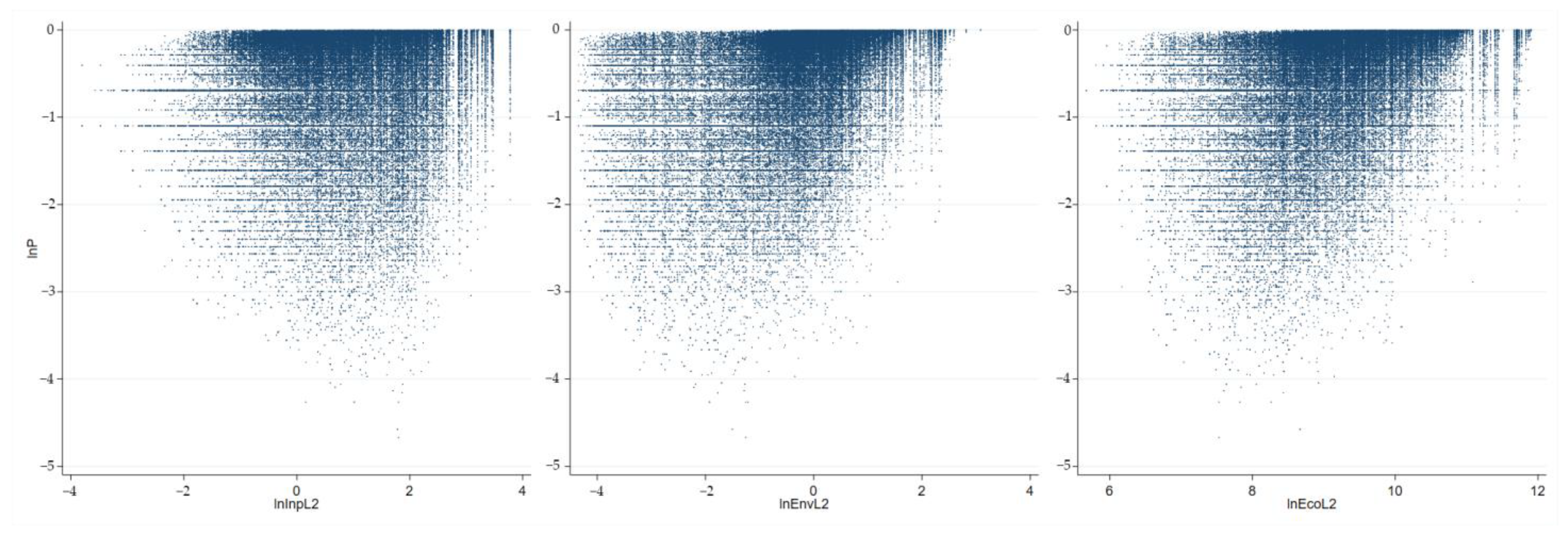
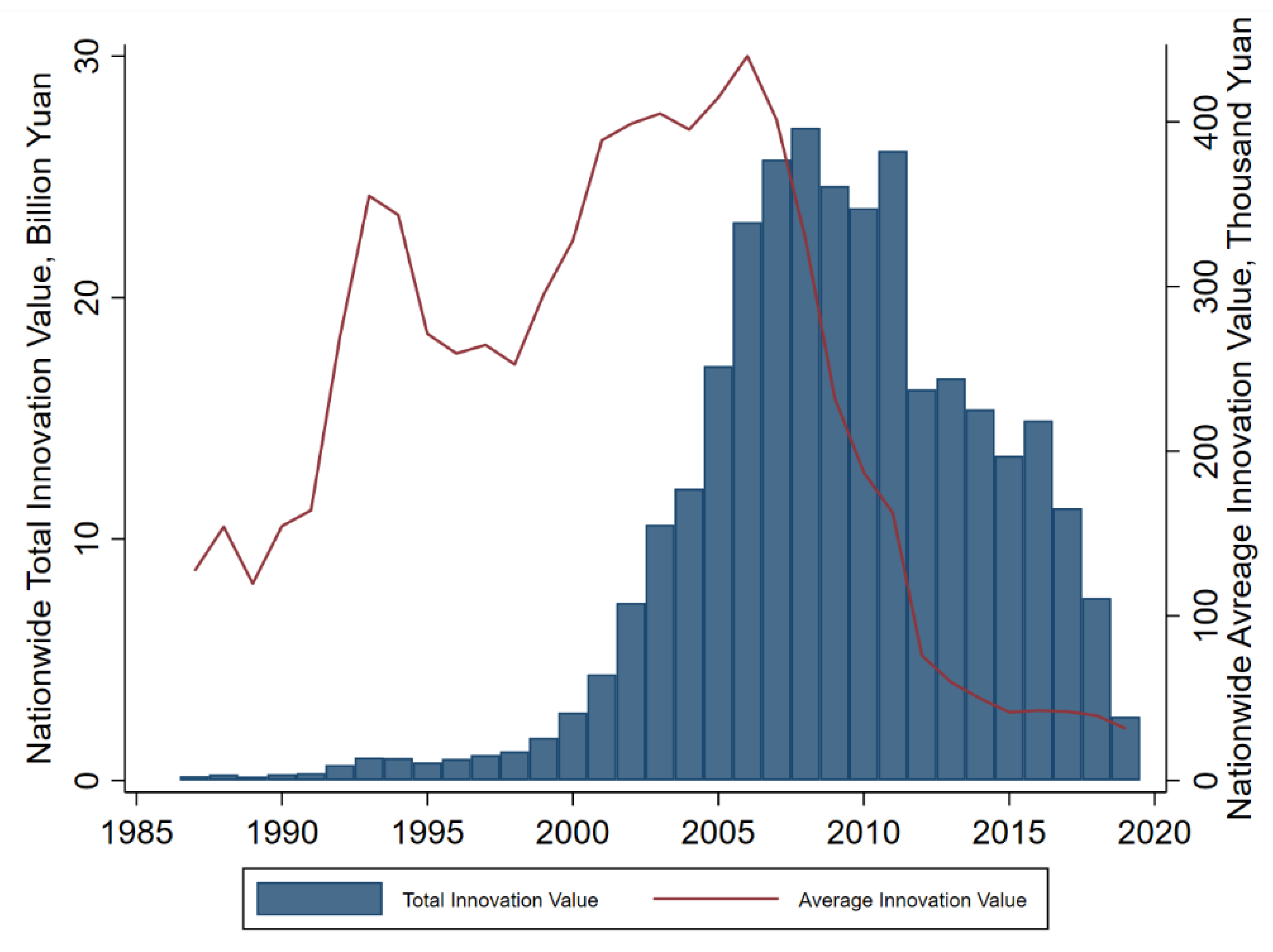
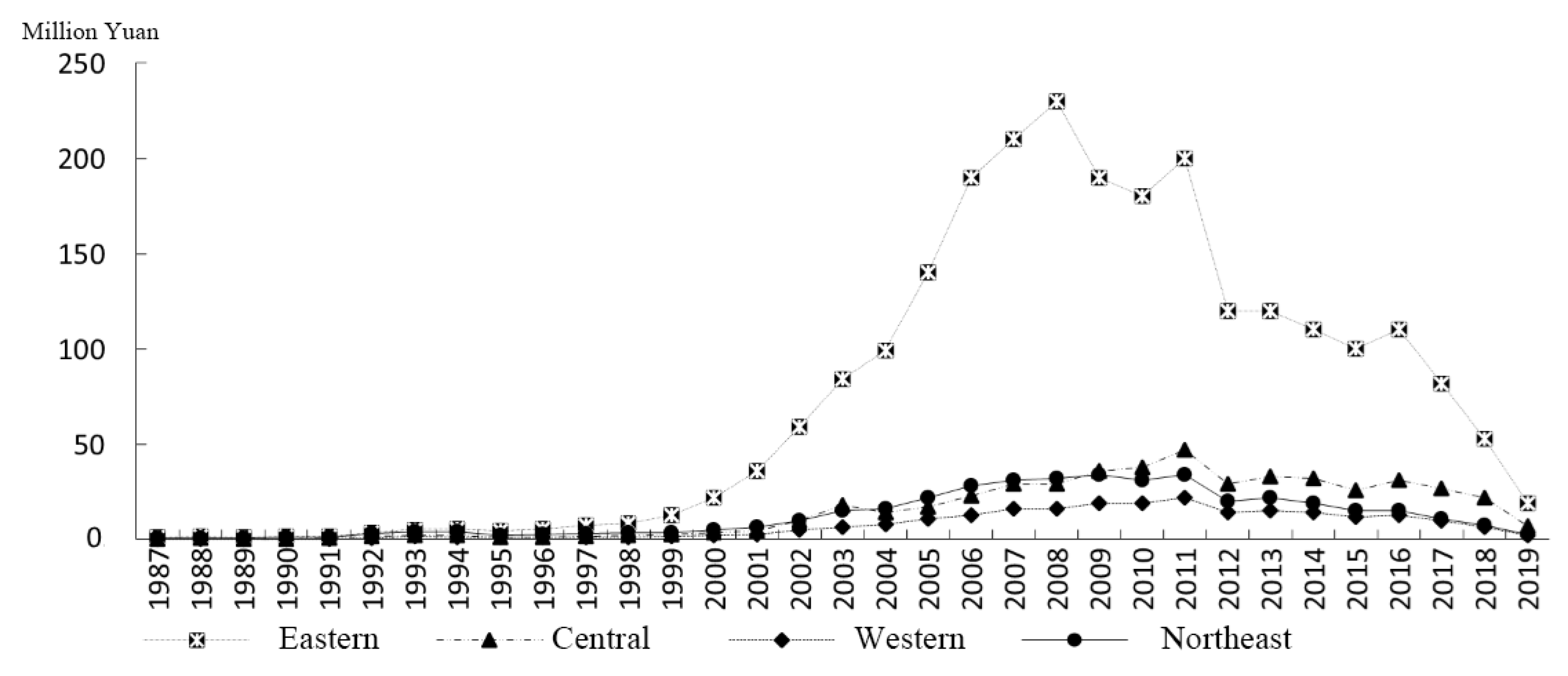

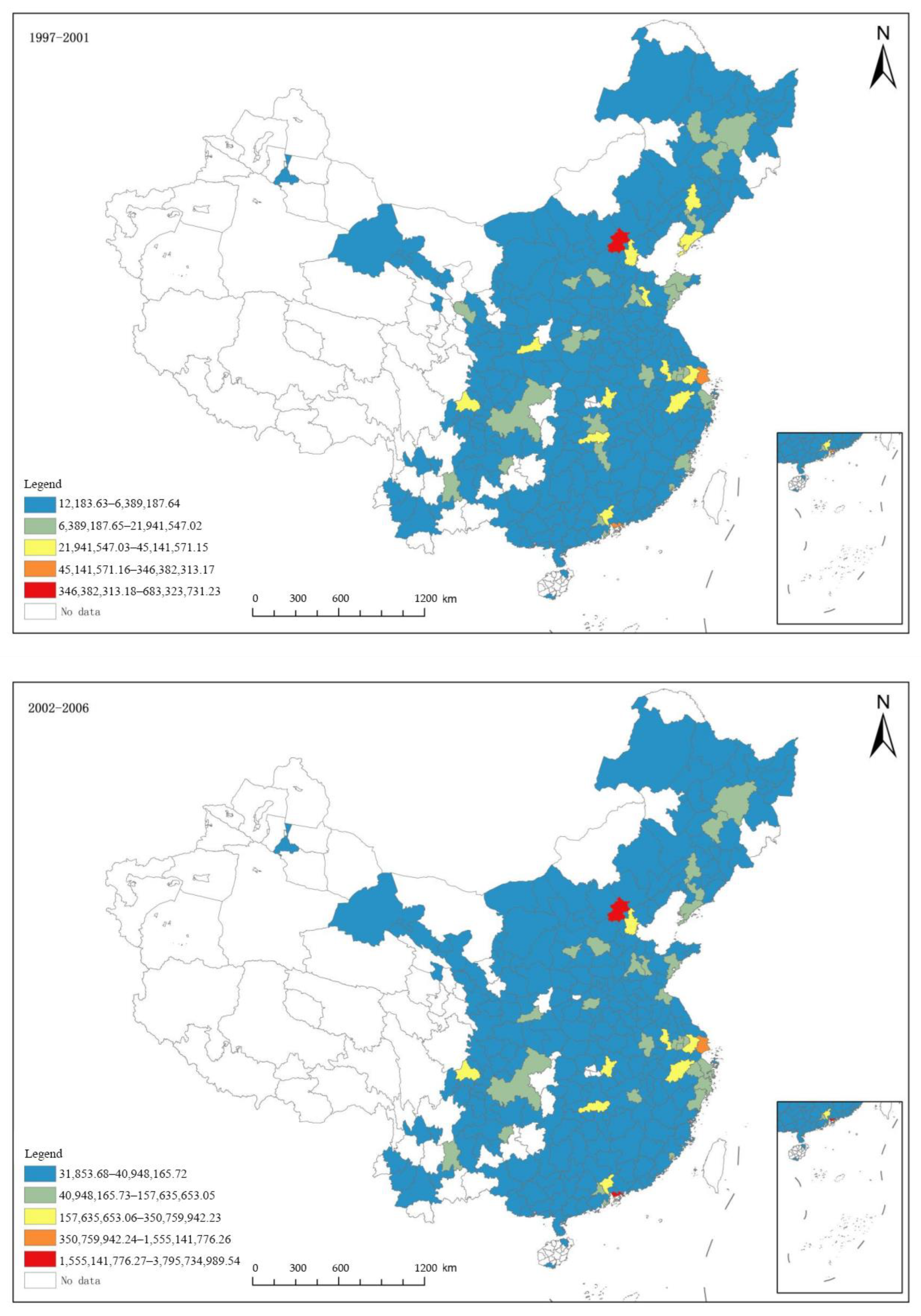
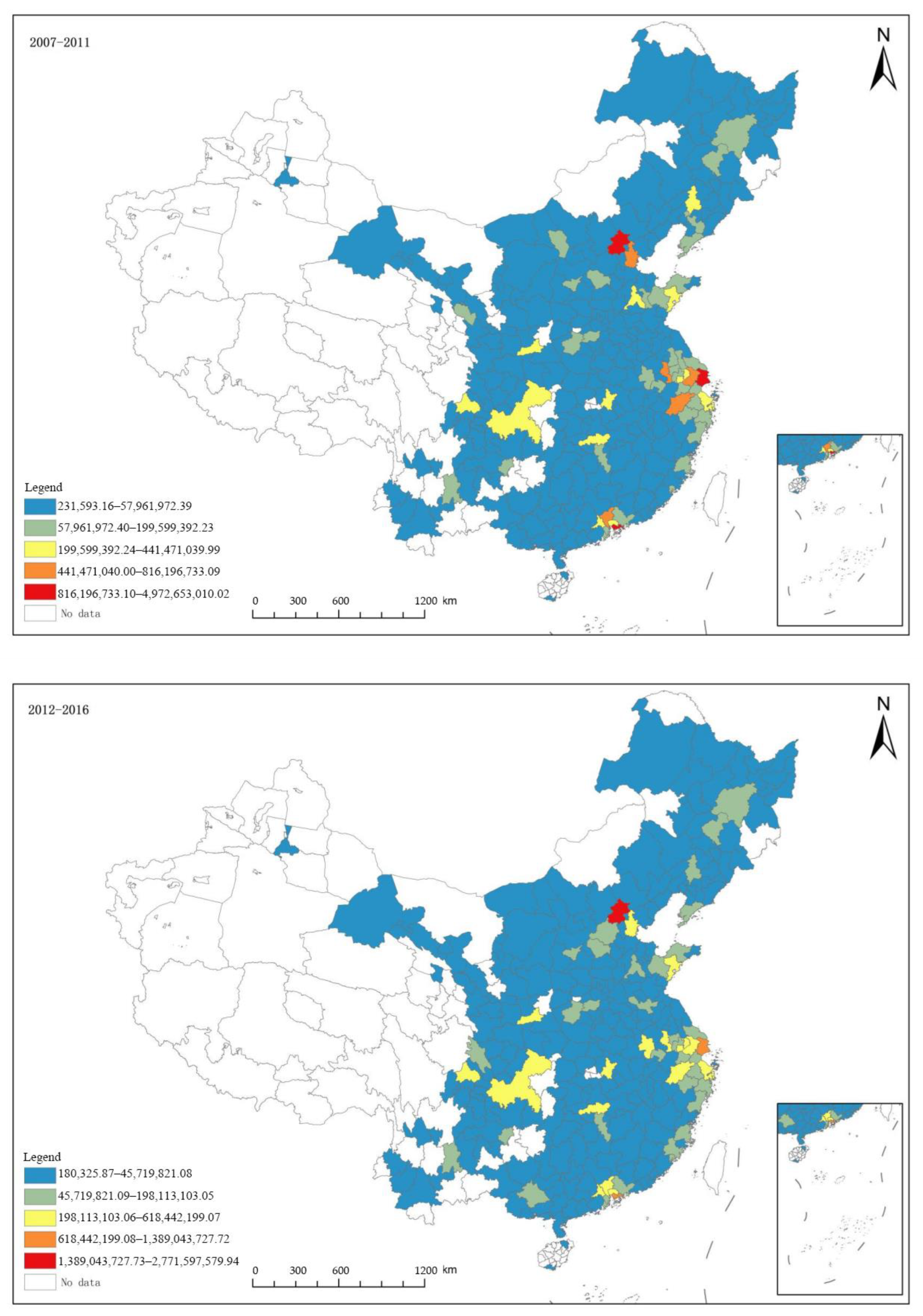

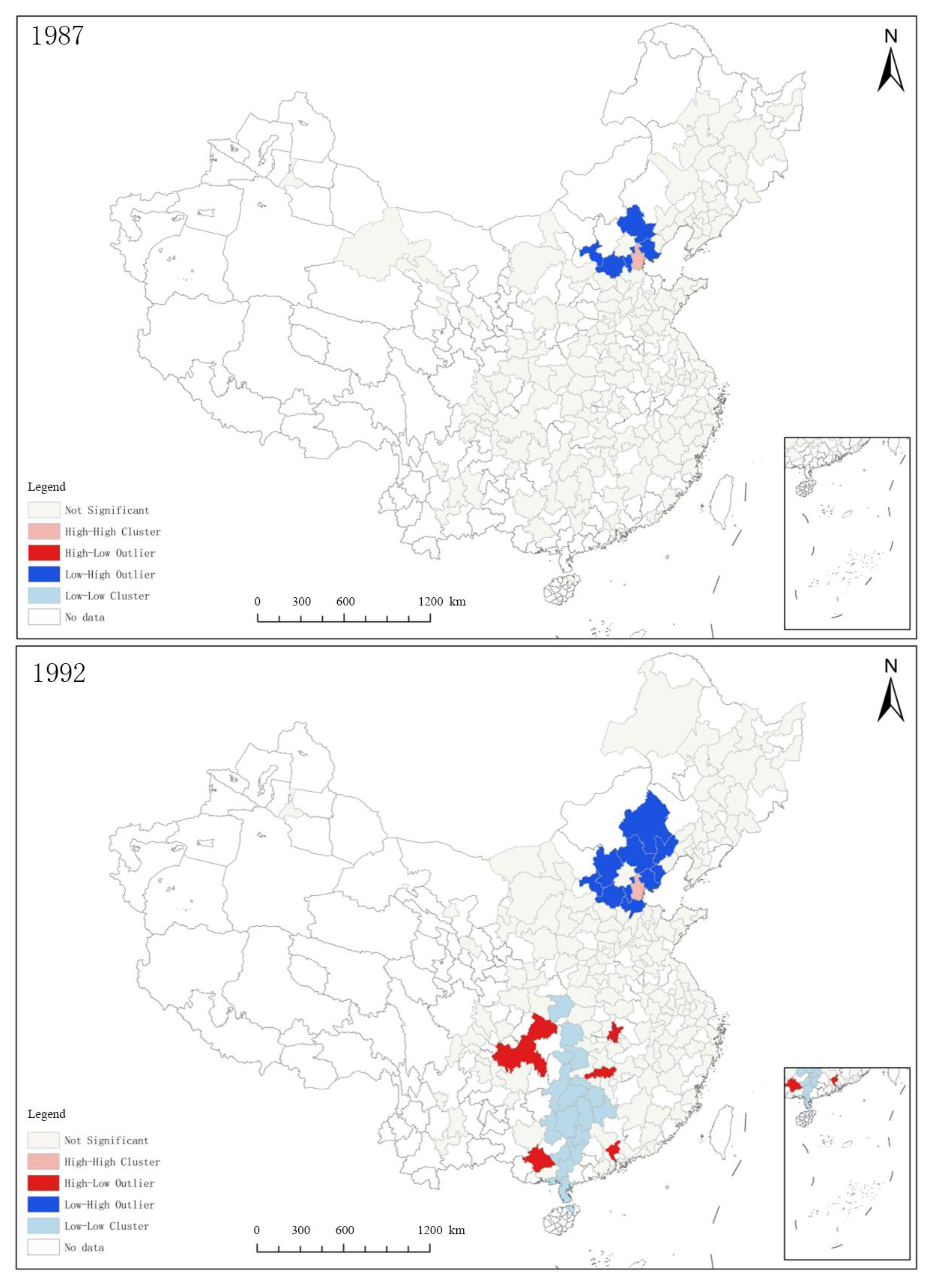
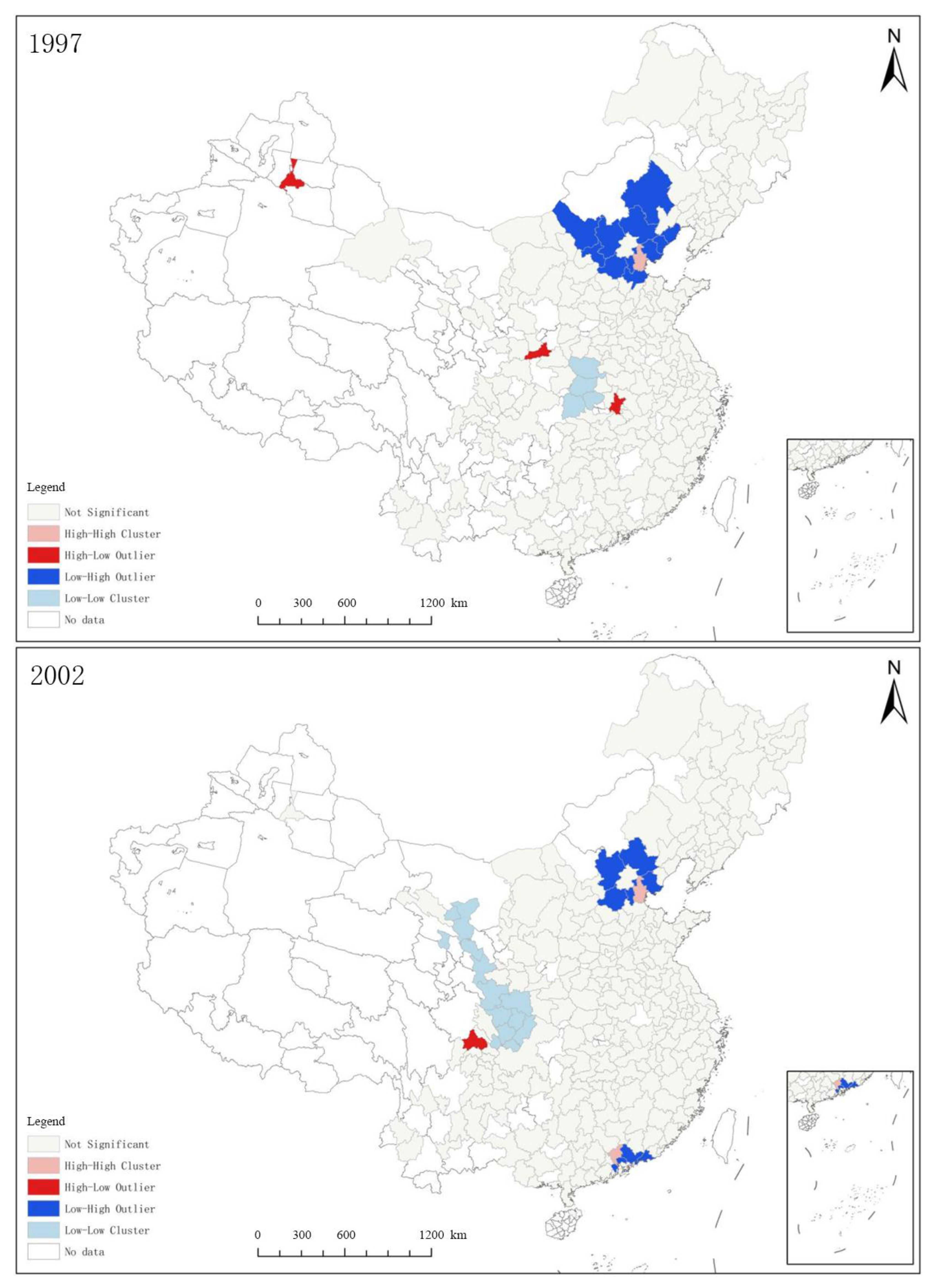

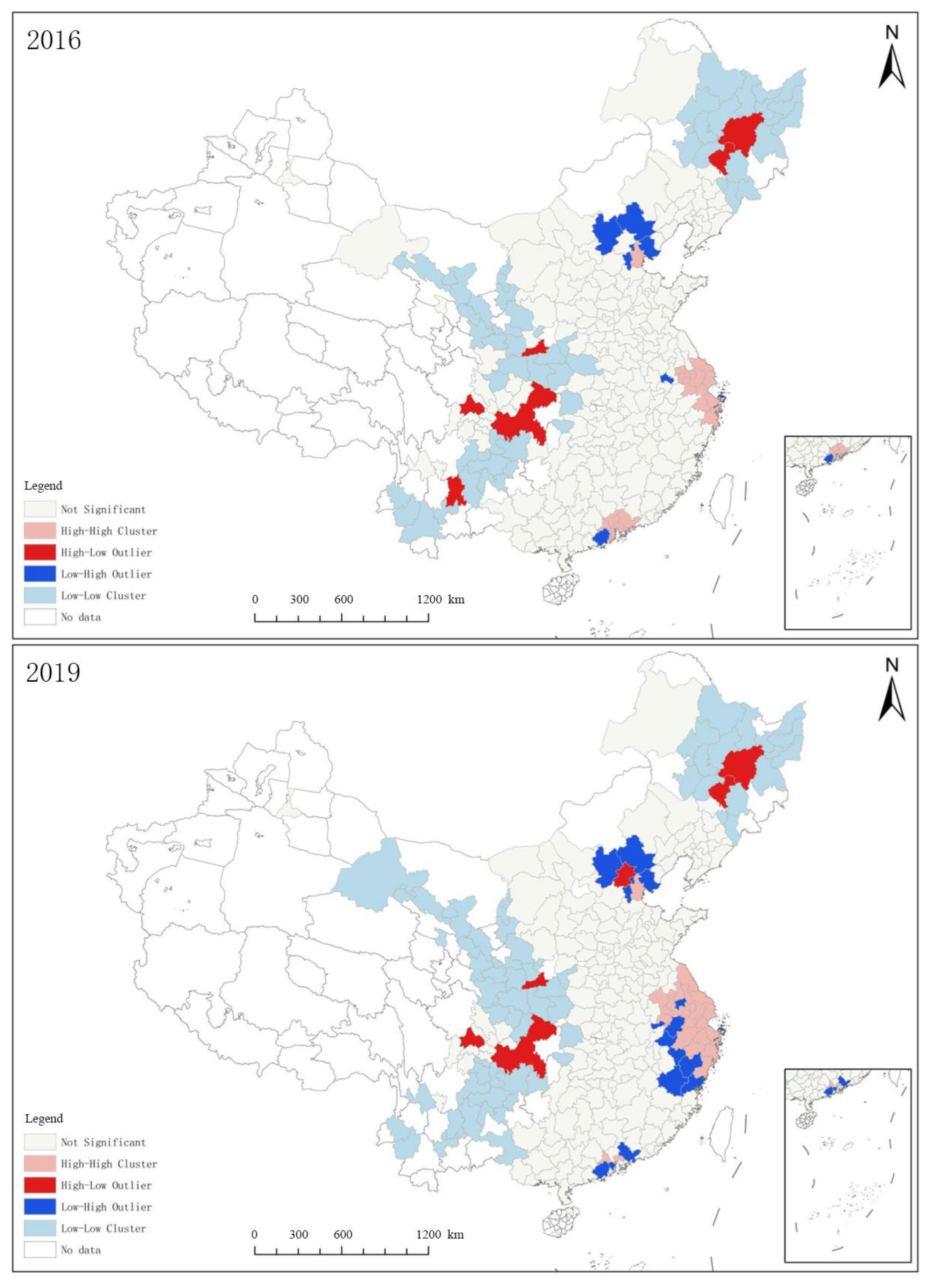

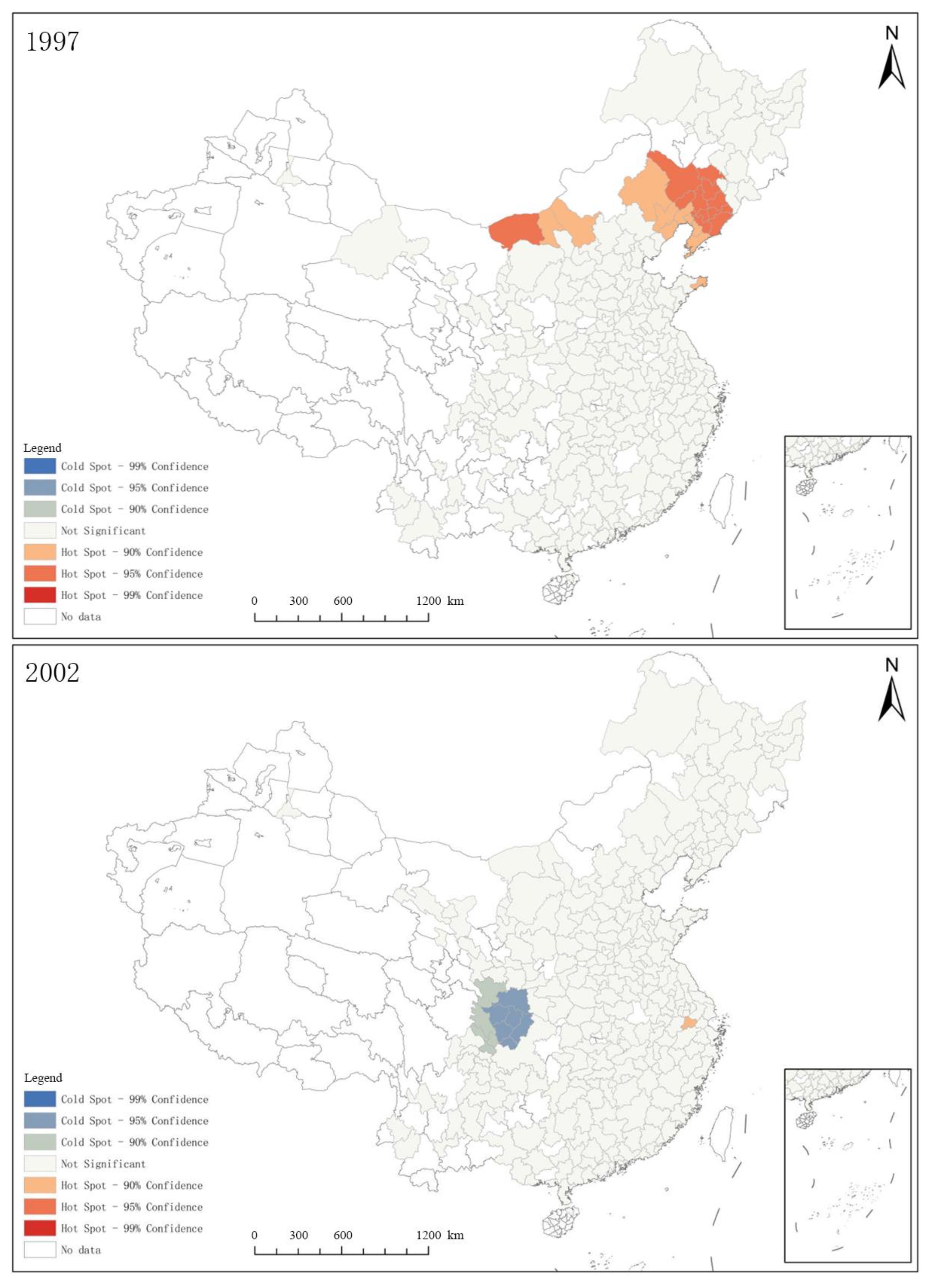

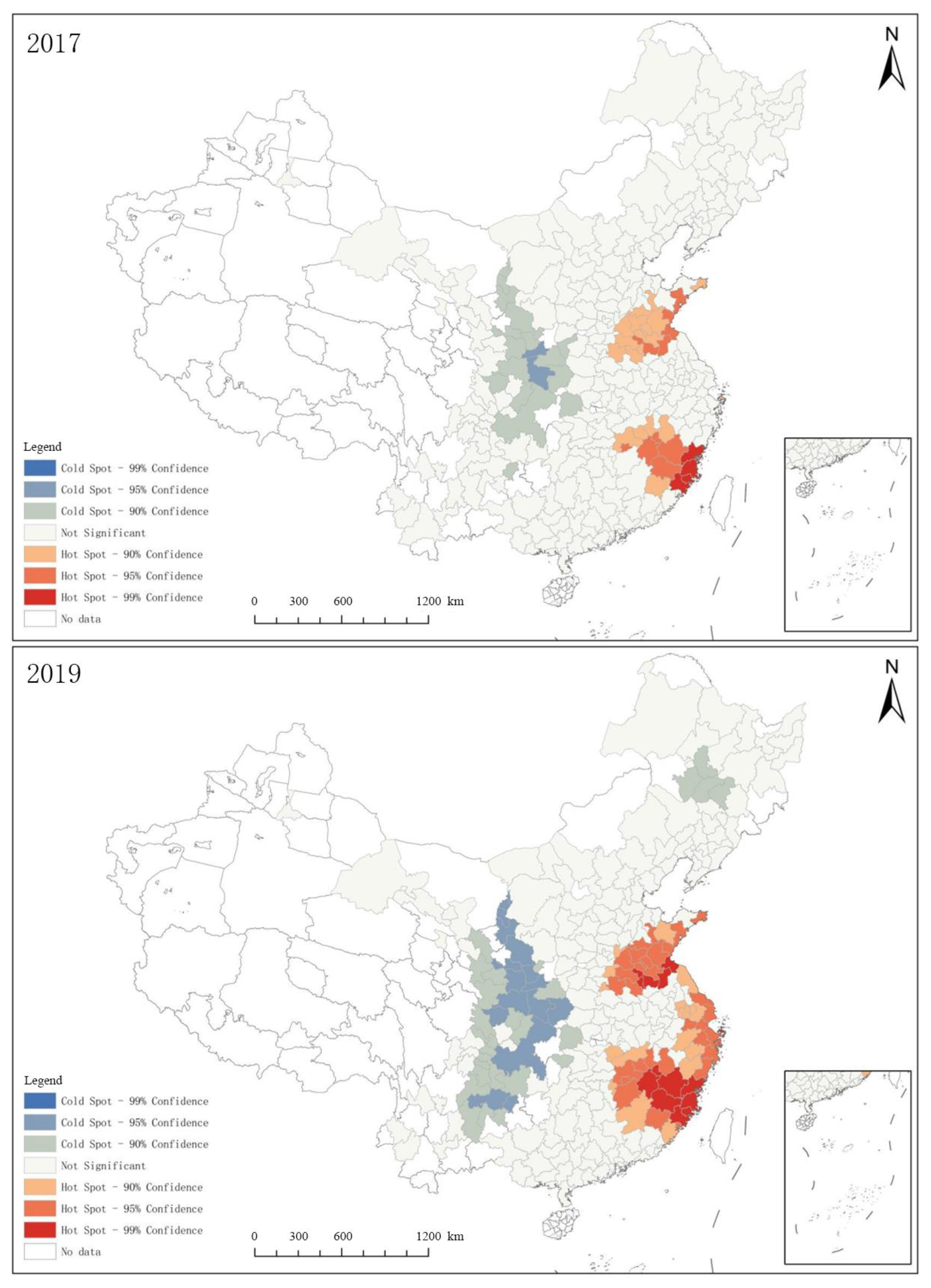
| Tier 1 Indicators | Tier 2 Indicators | Unit of Measure |
|---|---|---|
| Innovation Input | Number of R&D personnel per 10,000 people | Number/10,000 people |
| Government R&D spending as a proportion of fiscal expenditure | % | |
| Number of papers published in domestic academic journals per 10,000 people | Number/10,000 people | |
| Number of papers published in foreign academic journals per 10,000 people | Number/10,000 people | |
| Innovation Environment | Government educational spending as a proportion of fiscal expenditure | % |
| Ratio of telephone, mobile phone, and Internet subscribers to population | Ratio | |
| Number of national-level incubators for innovative enterprises | Number | |
| Number of patent agencies | Number | |
| Economic Environment | GRP per capita | Yuan/person |
| Average wage of employees | Yuan/person | |
| Amount of foreign capital actually used per capita | Yuan/person | |
| Ratio of total market value of listed enterprises to GRP | % |
| Category of Sample Patents | Total Number of Patents in the Cohort | Renewal Proportion (%) | Percentage of Unexpired Patents (%) | |||
|---|---|---|---|---|---|---|
| 5th Year | 10th Year | 15th Year | 20th Year | |||
| Whole Sample 1 | 2,799,639 | 73 | 16 | 2 | 1 | 78 |
| Year of Application | ||||||
| 1987 | 1447 | 92 | 25 | 7 | 2 | 0 |
| 1988 | 1589 | 90 | 25 | 7 | 2 | 0 |
| 1989 | 1436 | 87 | 26 | 7 | 3 | 0 |
| 1990 | 1652 | 88 | 27 | 8 | 4 | 0 |
| 1991 | 1857 | 86 | 30 | 8 | 3 | 0 |
| 1992 | 2394 | 88 | 36 | 11 | 6 | 0 |
| 1993 | 2711 | 95 | 43 | 13 | 8 | 0 |
| 1994 | 2738 | 98 | 39 | 15 | 9 | 0 |
| 1995 | 2808 | 99 | 35 | 19 | 10 | 0 |
| 1996 | 3474 | 96 | 32 | 18 | 11 | 0 |
| 1997 | 4020 | 92 | 32 | 19 | 12 | 0 |
| 1998 | 4817 | 92 | 34 | 22 | 12 | 0 |
| 1999 | 6051 | 91 | 38 | 25 | 12 | 0 |
| 2000 | 8670 | 89 | 46 | 26 | 13 | 0 |
| 2001 | 11,425 | 90 | 50 | 29 | 16 | |
| 2002 | 18,571 | 88 | 53 | 32 | 22 | |
| 2003 | 26,328 | 88 | 56 | 30 | 23 | |
| 2004 | 30,768 | 88 | 56 | 29 | 26 | |
| 2005 | 41,574 | 94 | 59 | 32 | 31 | |
| 2006 | 52,852 | 95 | 61 | 37 | ||
| 2007 | 64,338 | 96 | 62 | 41 | ||
| 2008 | 82,625 | 96 | 60 | 48 | ||
| 2009 | 106,456 | 94 | 57 | 53 | ||
| 2010 | 127,230 | 93 | 60 | 60 | ||
| 2011 | 161,289 | 93 | 69 | |||
| 2012 | 214,565 | 94 | 76 | |||
| 2013 | 280,558 | 91 | 80 | |||
| 2014 | 310,103 | 90 | 85 | |||
| 2015 | 325,582 | 92 | 91 | |||
| 2016 | 352,744 | 95 | ||||
| 2017 2 | 270,453 | 99 | ||||
| 2018 2 | 192,387 | 99 | ||||
| 2019 2 | 84,127 | 99 | ||||
| Type of Applicant 1 | ||||||
| Individual | 266,419 | 74 | 18 | 3 | 1 | 51 |
| Nonlisted firms | 1,425,615 | 77 | 21 | 3 | 1 | 87 |
| Listed firms | 189,437 | 96 | 54 | 6 | 2 | 90 |
| Public sector | 918,168 | 67 | 9 | 1 | 0 | 69 |
| Industrial Sectors 1 | ||||||
| Agriculture, forestry, livestock, and fisheries | 40,565 | 60 | 8 | 1 | 0 | 65 |
| Mining | 10,322 | 72 | 16 | 3 | 1 | 80 |
| Manufacturing | 2,367,409 | 73 | 16 | 3 | 1 | 78 |
| Electricity, heat, gas, and water production and supply | 5451 | 70 | 10 | 1 | 0 | 76 |
| Construction | 47,148 | 64 | 11 | 2 | 1 | 82 |
| Information transmission, software, and information | 84,106 | 79 | 16 | 2 | 0 | 86 |
| Technical services | 16,055 | 84 | 21 | 0 | 0 | 86 |
| Health and social work | 228,583 | 75 | 16 | 1 | 0 | 83 |
| Regional Innovation Indicators | Mean | Std. Dev. | Min | Max |
|---|---|---|---|---|
| Innovation Input | ||||
| Number of R&D personnel per 10,000 people | 15.04 | 0.29 | 0.22 | 524.42 |
| Government R&D spending as proportion of fiscal expenditure | 0.01 | 0.011 | 0.00 | 0.21 |
| Number of papers published in domestic academic journals per 10,000 people | 5.69 | 10.339 | 0.00 | 122.40 |
| Number of papers published in foreign academic journals per 10,000 people | 0.51 | 3.469 | 0.00 | 103.22 |
| Innovation Environment | ||||
| Government educational spending as a proportion of fiscal expenditure | 0.20 | 0.06 | 0.02 | 0.49 |
| Ratio of telephone, mobile phone, and Internet subscribers to population | 0.59 | 0.93 | 0.00 | 13.53 |
| Number of national-level incubators for innovative enterprises | 0.82 | 3.27 | 0.00 | 61.00 |
| Number of patent agencies | 2.01 | 14.94 | 0.00 | 637.00 |
| Economic Environment | ||||
| GRP per capita | 23,187.09 | 32,770.05 | 426.35 | 455,125.43 |
| Average wage of employees | 21,733.51 | 17,954.21 | 14.04 | 169,823.84 |
| Amount of foreign capital actually used per capita | 689.04 | 1807.53 | 0.04 | 30,415.53 |
| Ratio of total market value of listed enterprises to GRP | 0.16 | 0.38 | 0.00 | 7.69 |
| Parameters | Regional Innovation Value Model | Patent Renewal Model | ||
|---|---|---|---|---|
| (I) | (II) | (III) | ||
| μi0 1 | 10.195 *** | 9.354 *** | 9.973 *** | 10.330 *** |
| (0.075) | (0.063) | (0.085) | (0.045) | |
| b1 | 0.090 *** | 0.015 *** | 0.017 *** | |
| (0.003) | (0.003) | (0.004) | ||
| b2 | −0.055 *** | 0.026 *** | 0.028 *** | |
| (0.005) | (0.006) | (0.007) | ||
| b3 | 0.084 *** | 0.023 *** | 0.026 *** | |
| (0.006) | (0.006) | (0.006) | ||
| σ | 0.613 *** | 0.473 *** | 0.525 *** | 0.470 *** |
| (0.008) | (0.005) | (0.007) | (0.005) | |
| d | 0.744 *** | 0.813 *** | 0.757 *** | 0.814 *** |
| (0.004) | (0.003) | (0.005) | (0.003) | |
| θ1 | −0.029 *** | |||
| (0.004) | ||||
| θ2 | −0.048 *** | |||
| (0.003) | ||||
| Application year | Control | Control | Control 2 | |
| Application city | Control | |||
| Applicant type | Control | Control | ||
| Industrial sector | Control | Control | ||
| N | 503,185 | 503,185 | 503,185 | 503,185 |
| Adjusted R2 | 0.544 | 0.571 | 0.571 | 0.554 |
| WSSE | 0.164 | 0.156 | 0.155 | 0.163 |
| Parameters | Application Years 1987–1995 | Application Years 1987–2005 | Application Years 1987–2015 | Full Sample |
|---|---|---|---|---|
| μ0 | 9.326 *** | 8.929 *** | 9.975 *** | 9.973 *** |
| (0.117) | (0.086) | (0.089) | (0.085) | |
| b1 | 0.059 *** | 0.039 *** | 0.020 *** | 0.017 *** |
| (0.005) | (0.004) | (0.004) | (0.004) | |
| b2 | 0.072 *** | 0.066 *** | 0.036 *** | 0.028 *** |
| (0.012) | (0.008) | (0.007) | (0.007) | |
| b3 | 0.012 | 0.065 *** | 0.027 *** | 0.026 *** |
| (0.010) | (0.007) | (0.007) | (0.006) | |
| σ | 0.387 *** | 0.444 *** | 0.526 *** | 0.525 *** |
| (0.008) | (0.007) | (0.007) | (0.007) | |
| d | 0.844 *** | 0.831 *** | 0.756 *** | 0.757 *** |
| (0.007) | (0.006) | (0.006) | (0.005) | |
| θ1 | −0.047 *** | 0.035 *** | −0.029 *** | −0.029 *** |
| (0.004) | (0.003) | (0.004) | (0.004) | |
| θ2 | −0.053 *** | −0.072 *** | −0.049 *** | −0.048 *** |
| (0.010) | (0.004) | (0.003) | (0.003) | |
| Application Year | Control | Control | Control | Control |
| Applicant Type | Control | Control | Control | Control |
| Industrial Sector | Control | Control | Control | Control |
| N | 83,480 | 250,729 | 472,345 | 503,185 |
| Corrected R2 | 0.601 | 0.537 | 0.558 | 0.571 |
| WSSE | 0.140 | 0.148 | 0.155 | 0.155 |
| City | 1987 | City | 2000 | City | 2010 | City | 2019 3 | ||||||||
|---|---|---|---|---|---|---|---|---|---|---|---|---|---|---|---|
| Total Value 1 | Average Value 2 | Patent Count | Total Value 1 | Average Value 2 | Patent Count | Total Value 1 | Average Value 2 | Patent Count | Total Value 1 | Average Value 2 | Patent Count | ||||
| (Top 10) | |||||||||||||||
| Beijing | 43.047 | 156.534 | 275 | Beijing | 880.376 | 475.109 | 1853 | Beijing | 4447.088 | 212.150 | 20,962 | Beijing | 339.010 | 31.239 | 10,852 |
| Shanghai | 23.029 | 195.159 | 118 | Shenzhen | 434.092 | 885.903 | 490 | Shenzhen | 3237.263 | 253.446 | 12,773 | Shenzhen | 136.491 | 45.695 | 2987 |
| Tianjin | 7.398 | 117.423 | 63 | Shanghai | 307.806 | 386.691 | 796 | Shanghai | 2259.849 | 203.553 | 11,102 | Zhuhai | 125.842 | 83.174 | 1513 |
| Xi’an | 5.089 | 99.792 | 51 | Chengdu | 54.503 | 283.869 | 192 | Hangzhou | 816.793 | 167.857 | 4866 | Shanghai | 118.432 | 34.338 | 3449 |
| Wuhan | 4.830 | 74.304 | 65 | Nanjing | 52.611 | 256.640 | 205 | Suzhou | 779.760 | 209.051 | 3730 | Hangzhou | 114.926 | 28.645 | 4012 |
| Guangzhou | 3.656 | 130.573 | 28 | Guangzhou | 52.460 | 200.231 | 262 | Guangzhou | 681.848 | 187.013 | 3646 | Nanjing | 99.734 | 29.763 | 3351 |
| Changchun | 3.654 | 87.000 | 42 | Suzhou | 45.023 | 372.088 | 121 | Nanjing | 585.924 | 141.801 | 4132 | Wuhan | 95.802 | 28.487 | 3363 |
| Kunming | 3.582 | 132.664 | 27 | Wuhan | 42.881 | 180.931 | 237 | Wuxi | 497.617 | 198.017 | 2513 | Guangzhou | 87.470 | 33.694 | 2596 |
| Chengdu | 3.341 | 128.498 | 26 | Tianjin | 42.058 | 200.275 | 210 | Tianjin | 488.531 | 174.725 | 2796 | Suzhou | 65.593 | 40.766 | 1609 |
| Shenyang | 3.258 | 66.496 | 49 | Hangzhou | 41.008 | 262.871 | 156 | Chengdu | 440.580 | 162.997 | 2703 | Chengdu | 61.501 | 24.328 | 2528 |
| (Bottom 10) | |||||||||||||||
| Anyang | 0.005 | 4.824 | 1 | Ji’an | 0.023 | 11.743 | 2 | Liupanshui | 0.650 | 108.322 | 6 | Guangyuan | 0.047 | 15.573 | 3 |
| Qinhuangdao | 0.005 | 4.823 | 1 | Anqing | 0.019 | 9.643 | 2 | Bazhong | 0.620 | 155.021 | 4 | Songyuan | 0.037 | 36.718 | 1 |
| Zaozhuang | 0.005 | 4.819 | 1 | Jixi | 0.015 | 7.697 | 2 | Yichun | 0.602 | 150.454 | 4 | Lijiang | 0.037 | 36.535 | 1 |
| Zhoukou | 0.005 | 4.818 | 1 | Wuzhong | 0.012 | 11.826 | 1 | Wuhai | 0.542 | 90.315 | 6 | Qitaihe | 0.037 | 36.522 | 1 |
| Hebi | 0.005 | 4.816 | 1 | Jinchang | 0.012 | 11.621 | 1 | Tongchuan | 0.502 | 251.113 | 2 | Baoshan | 0.036 | 35.914 | 1 |
| Zhangzhou | 0.003 | 3.393 | 1 | Chongzuo | 0.012 | 11.614 | 1 | Jiayuguan | 0.464 | 115.906 | 4 | Guangan | 0.028 | 14.220 | 2 |
| Baishan | 0.003 | 3.362 | 1 | Chizhou | 0.012 | 11.607 | 1 | Fangchenggang | 0.403 | 134.370 | 3 | Wuwei | 0.025 | 12.630 | 2 |
| Linfen | 0.003 | 3.349 | 1 | Baiyin | 0.012 | 11.599 | 1 | Chongzuo | 0.372 | 123.833 | 3 | Longnan | 0.016 | 15.965 | 1 |
| Xinyang | 0.003 | 3.340 | 1 | Tongling | 0.008 | 7.697 | 1 | Qitaihe | 0.170 | 42.481 | 4 | Pingliang | 0.012 | 12.451 | 1 |
| Zunyi | 0.003 | 3.307 | 1 | Xuancheng | 0.008 | 7.693 | 1 | Hegang | 0.008 | 8.405 | 1 | Zhaotong | 0.012 | 12.287 | 1 |
| Average of all Sample Cities | 1.072 | 127.201 | 8 | 10.815 | 327.895 | 33 | 37.503 | 111.990 | 335 | 9.514 | 31.523 | 302 |
| Year | HH Cluster (Promotion Area) | LH Outlier (Transition Area) | LL Cluster (Low-Level Area) | HL Outlier (Radiation Area) |
|---|---|---|---|---|
| 1987 | Beijing, Tianjin, Hebei, Shanghai Jiangsu, Zhejiang | Jilin, Hainan | Shanxi, Inner Mongolia, Heilongjiang, Anhui, Fujian, Jiangxi, Guangxi, Chongqing, Guizhou, Yunnan, Gansu, Qinghai, Ningxia, Xinjiang | Liaoning, Shandong, Henan, Hubei, Hunan, Guangdong, Sichuan, Shaanxi |
| 1992 | Tianjin, Shanghai, Jiangsu, Zhejiang | Hebei, Jilin, Anhui, Hainan | Shanxi, Inner Mongolia, Heilongjiang, Fujian, Jiangxi, Guangxi, Chongqing, Guizhou, Yunnan, Shaanxi, Gansu, Qinghai, Ningxia, Xinjiang | Beijing, Liaoning, Shandong, Henan, Hubei, Hunan, Guangdong, Sichuan |
| 1997 | Shanghai, Jiangsu | Tianjin, Hebei, Fujian, Hainan | Shanxi, Inner Mongolia, Jilin, Heilongjiang, Anhui, Jiangxi, Henan, Guangxi, Guangxi, Chongqing, Guizhou, Yunnan, Shaanxi, Gansu, Qinghai, Ningxia, Xinjiang | Beijing, Liaoning, Zhejiang, Shandong, Hubei, Hunan, Guangdong, Sichuan |
| 2002 | Shanghai, Jiangsu, Zhejiang, Hunan | Tianjin, Hebei, Fujian, Jiangxi, Guangxi, Hainan | Shanxi, Inner Mongolia, Liaoning, Jilin, Heilongjiang, Anhui, Henan, Hubei, Chongqing, Sichuan, Guizhou, Yunnan, Shaanxi, Gansu, Qinghai, Ningxia, Xinjiang | Beijing, Guangdong, Shandong |
| 2007 | Shanghai, Jiangsu, Zhejiang | Tianjin, Hebei, Anhui, Fujian, Jiangxi, Hunan, Guangxi | Shanxi, Inner Mongolia, Liaoning, Jilin, Heilongjiang, Henan, Hubei, Hainan, Chongqing, Sichuan, Guizhou, Yunnan, Shaanxi, Gansu, Qinghai, Ningxia, Xinjiang | Beijing, Shandong, Guangdong |
| 2012 | Shanghai, Jiangsu, Zhejiang, Anhui, Shandong | Tianjin, Hebei, Fujian, Jiangxi, Hunan, Guangxi, Hainan | Shanxi, Inner Mongolia, Liaoning, Jilin, Heilongjiang, Henan, Hubei, Chongqing Guizhou, Yunnan, Shaanxi Gansu, Qinghai, Ningxia, Xinjiang | Beijing, Guangdong, Sichuan |
| 2017 | Shanghai Jiangsu, Zhejiang, Anhui, Shandong | Tianjin, Hebei, Fujian, Jiangxi, Hunan, Guangxi, Hainan | Shanxi, Inner Mongolia, Liaoning, Jilin, Heilongjiang, Henan, Chongqing, Guizhou, Yunnan, Shaanxi, Gansu, Qinghai, Ningxia, Xinjiang | Beijing, Hubei, Guangdong, Sichuan |
| 2019 | Shanghai, Jiangsu, Jiangsu, Zhejiang, Anhui, Shandong | Tianjin, Fujian, Jiangxi, Hunan, Guangxi, Hainan | Hebei, Shanxi, Inner Mongolia, Liaoning, Jilin, Heilongjiang, Henan, Chongqing, Guizhou, Yunnan, Shaanxi, Gansu, Qinghai, Ningxia, Xinjiang | Beijing, Hubei, Guangdong, Sichuan |
Disclaimer/Publisher’s Note: The statements, opinions and data contained in all publications are solely those of the individual author(s) and contributor(s) and not of MDPI and/or the editor(s). MDPI and/or the editor(s) disclaim responsibility for any injury to people or property resulting from any ideas, methods, instructions or products referred to in the content. |
© 2023 by the author. Licensee MDPI, Basel, Switzerland. This article is an open access article distributed under the terms and conditions of the Creative Commons Attribution (CC BY) license (https://creativecommons.org/licenses/by/4.0/).
Share and Cite
Zhang, Y. The Sustainability of Regional Innovation in China: Insights from Regional Innovation Values and Their Spatial Distribution. Sustainability 2023, 15, 10398. https://doi.org/10.3390/su151310398
Zhang Y. The Sustainability of Regional Innovation in China: Insights from Regional Innovation Values and Their Spatial Distribution. Sustainability. 2023; 15(13):10398. https://doi.org/10.3390/su151310398
Chicago/Turabian StyleZhang, Yipeng. 2023. "The Sustainability of Regional Innovation in China: Insights from Regional Innovation Values and Their Spatial Distribution" Sustainability 15, no. 13: 10398. https://doi.org/10.3390/su151310398
APA StyleZhang, Y. (2023). The Sustainability of Regional Innovation in China: Insights from Regional Innovation Values and Their Spatial Distribution. Sustainability, 15(13), 10398. https://doi.org/10.3390/su151310398





